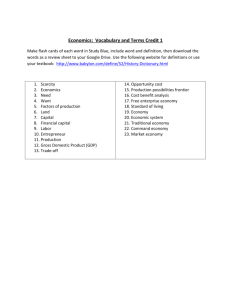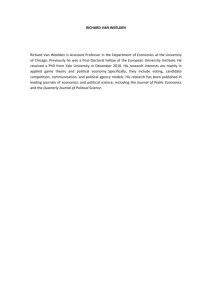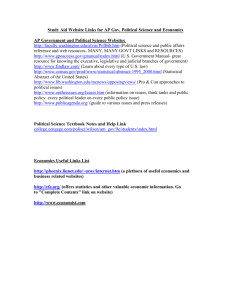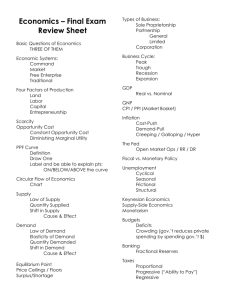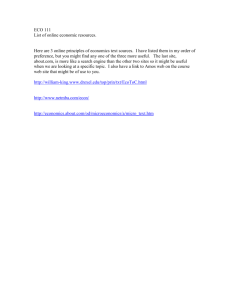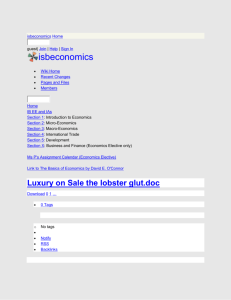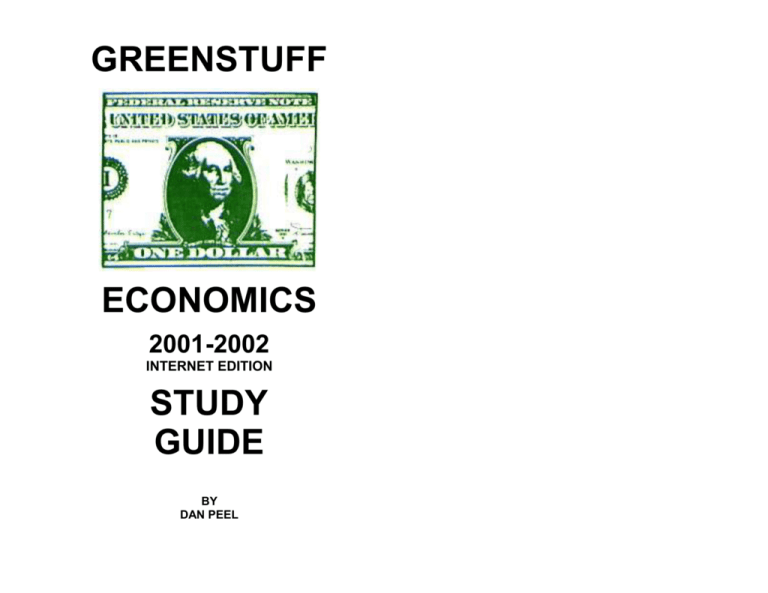
GREENSTUFF
ECONOMICS
2001-2002
INTERNET EDITION
STUDY
GUIDE
BY
DAN PEEL
GREENSTUFF ECONOMICS STUDY GUIDE
I firmly believe that students are much smarter than most
people give them credit for. In fact, I get really upset at the typical
response I get when I tell people the level at which I teach. I'm
getting tired of immediately saying afterward that this year my
students won the Economics America STOCK MARKET
GAME… again. They can read the stock market "ticker" on TV
and look up a stock in the newspaper, the Standard and Poor's
Stock Guide, and even in Value Line!
Students will come up and ask me, "Mr. Peel, what do you
think of this stock? It's got a high Beta and a low P/E ratio, but its
current assets to liabilities is pretty good."
Six months later, they may not remember all that I've
taught them. I have this theory that there are some things we
learn in middle school, relearn In high school, and go over again
in college. Later on in life, some "life experience " connects up
with what we've been taught, and we think we learned it on our
own!
Attitudes and values about money are formed at an early
age. That's why it's important to begin learning about money
early in life.
Students are much smarter than most people think they
are. That's why students are the editors of Greenstuff Economics.
HOW TO USE THE BOOK AND STUDY GUIDE
Read all the way to the end of each paragraph. (Don't stop if you come to a
word that you don’t know. There are enough "contextual clues" surrounding
each new word to give you a good idea of its meaning.)
When you finish a chapter, use the study guide and the handbook to define the
terms. Economic terms are in, bold type and underlined. Definitions are
immediately after each term.
Circle any paragraph that you still don't understand or that you think could be
explained better!
Page 1
USING THIS STUDY GUIDE
1. Read through an entire chapter of the book FIRST.
2. Then look up the definitions for the terms that are listed for the chapter in
this Study Guide.
3. Write out the definitions in your Study Guide.
4. Study these terms for the chapter quiz.
Text, Diagrams, & Charts
(c) 1986, 2001 by Dan Peel
All rights reserved
HistoryClassroom.com
P.O. BOX 203
Roselle, IL. 60172
Original Graphic Illustrations courtesy of:
The Print Shop and The Print Shop
Graphics Library (Disk 1, 2. & 3)
Borderbund Software
17 Paul Drive
San Rafael, California 94903-2101
All rights reserved
Original Clip Art courtesy of:
The Newsroom (c) 1985 Springboard Software, Inc.
7808 Creekside Circle
Minneapolis, MN. 55435
All rights reserved
Page 2
Greenstuff Economics Study Guide Name_______________________
Author's Note & Introduction
1. Barter
2. Capital Goods
3. Coins
4. Consumers
S. Federal Reserve
6. Gold Standard
7. Inflation
8. Interdependent
9. Law of Supply & Demand
10. Medium of Exchange
11. Money
12. Producer
13. Specialist
14. Standard of Value
(Greenstuff Economics Pre/Post overlays A-Z & Overlays 1-6)
Page 4
Greenstuff Economics Study Guide ____________________________
Chapter 1 Greenstuff - How To Get it!
1. Transfer Agent
2. Consumer Expenditures
3. Productive Services
4. Consumer Goods & Services
5. Income Payments
6. Imports
7. Exports
8. Federal Reserve
9. Producer
10. Consumer
11. Government
(Greenstuff Economics Overlays 7-10)
(c) 1986, 2001 Dan Peel
Page 5
Greenstuff Economics Study Guide ____________________________
Chapter 2 A Plan For Spending
SCARCITY, CHOICE. AND INTERDEPENDENCE
REMEMBER: It's O.K. to spend more than the "average" in some areas and less
than the "average" In other areas. It's your choice! That's what economics deals
with. The SCARCITY of money or natural resources, the CHOICES that must
be made, and our INTERDEPENDENCE (we depend on others to make the
goods and services that we don't make ourselves).
____ Your Car Payment
+____ Your Rent Payment
$1,893.30 Monthly take-home pay
-$________Total Spent
+____ Your "Other Expenses"
(P.19)
=$________Amount left for recreation
and entertainment (or extra savings).
____ = Total Spent
Number of students 2nd
3rd 4th
6th
7th
8th
9th
10th
Total
that choose:
Block Block Block Block Block Block Block Block Number
Used Camaro
($228.27 a month)
Used Mustang
($179.21 a month)
1 Bedroom
Apartment ($779 a
month)
2 Bedroom
Apartment ($476.50
EACH person)
Other expenses
Spent MORE than
the Average ($425)
Spent LESS than the
Average ($425)
(Greenstuff Economics Overlays 11-13)
(c) 1986, 2001 Dan Peel
Page 6
Greenstuff Economics Study Guide ____________________________
Chapter 2 A Plan For Spending &
Chapter 3 Seven Menacing Money Myths
1. An economy simply deals with how goods are made, distributed, and
used. It answers 4 questions:
a. What _________________________
b. How __________________________
c. How many ______________________
d. Who __________________________
2. Three basic principles that we all must deal with everyday are:
1. Scarcity 2. _______________ 3. ___________________
"Economy of Scale" is ________________________________
Write out the seven menacing money myths (excuses for not saving) in
the left-hand column. Then match each one with an answer from the
right-hand column.
Matching questions
7 menacing money myths:
7 answers to these "myths":
a. You also owe it to yourself to
have the things you really want.
b. You'll probably live to be over
70 years old. Plan ahead!
c. True, but you'll have less later on
because of interest charges.
d. You'll have very little money (no
matter how much you make) If you
don't learn how to manage It.
e. PAY YOURSELF FIRST!
f. True, IF you're buying necessities
that you will definitely use (during
times high inflation).
9. True, that's why you should
"create a reserve" for emergencies.
(Greenstuff Economics Overlays 14-20)
(c) 1986, 2001 Dan Peel
Page 7
Greenstuff Economics Study Guide ____________________________
Chapter 4 Greenstuff In Our Political/Economic System
1. Capitalistic
2. Free Enterprise
3. Incentive
-------------------------------------4. Free Choice
5. Responsibility
6. Social Order
7. Private ownership
8. Enterprise
9. Capital
10. Productivity
11. Competition
12. Profit
(Greenstuff Economics Overlays 21-22)
(c) 1986,2001 Dan Peel
Page 8
DIRECTIONS: Write COMMUNISM. DEMOCRACY, FASCISM. & SOCIALISM
in the correct spaces on the chart below.
POLITICAL SYSTEMS SIMPLIFIED
QuickTime™ and a
GIF decompressor
are needed to see this picture.
Page 9
Greenstuff Economics Study Guide ___________________________
Chapter 5 Creating Personal Wealth
1.
a. To legally delay taxes by doing some tax
planning (opening an Individual Retirement
Account. etc.)
2.
3.
b. Changing some taxable dollars of Income
to non-taxable income by doing some
planning. (Buying tax-free Municipal
Bonds, etc.)
4.
c. Using money to buy something that will
produce a profit.
5.
d. Asking yourself 3 questions before
buying (1) Is It a "need" or a "want"? (2) Is
It a good price? (3) Is It guaranteed and can
I return It to the retailer?
6.
7.
e. Owners of stock In a corporation
8.
f. The cost of replacing tools as they wear
out.
9.
9. The cost of employee's wages, social
security, fringe benefits, etc.
10.
h. The cost of natural resources and other
goods and services purchased from others in
order to produce a product or service.
I. The cost of making payments ordered by
the government.
J. What is left after all expenses have been
paid.
(Greenstuff Economics Overlays 23-25)
(c) 1986, 2001 Dan Peel
Page 10
Write the correct word in each space below.
YOU PAY THESE FIVE COSTS
WHENEVER YOU BUY SOMETHING
QuickTime™ and a
GIF decompressor
are needed to see this picture.
Page 11
Greenstuff Economics Study Guide _____________________________
Chapter 6 Choice, The Magic of Compounding, and S.L.Y. Investing
1. The Rule of 72
2. The Magic of Compounding
3. Investing
4. Capital Gains
5. Liquidity
6. Safety
7. Yield
8. Save
9. S.L.Y. Investors
10. The basic building block (or "cost") for improving your lifestyle.
(Greenstuff Economics Overlays 26-28)
(c) 1986, 2001 Dan Peel
Page 12
Greenstuff Economics Study Guide ______________________________
Chapter I Seven Investing Impasses
1. Diversify
2. Assets
3. Assayed
4. F.D.I.C. (Federal Deposit Insurance Corporation) p.41
5. S.E.C. (Securities Exchange Commission) p.42
6. Inflation Hedge
7. No-Load
8. Mutual Funds
9. Prospectus
10. Purchasing Power
11. Money Market Accounts
12. Money Market Funds
(Greenstuff Economics Overlays 29-35)
(c) 1986, 2001 Dan Peel
Page 13
Greenstuff Economics Study Guide ___________________________
Chapter 8 Bears, Bulls, and Pigs
1. Dollar Cost Averaging (D.C.A.)
2. Sell Short
3. Bear Market
4. Bull Market
5. "Pigs"
6. Fundamental Analysis
7. Technical Analysis
8. Contrarians
9. P.E.E.L. Principle
10. Five-year rule
(Greenstuff Economics Overlays 36-39)
(c) 1986, 2001 Dan Peel
Page 14
Greenstuff Economics Study Guide ________________________________
Chapter 9 Buyer's Bonanza
(How to save 10%-50% on everything you buy!)
(Will be an open book quiz)
1. A good place to find coupons is the __________________________.
(These coupons will save you money if you are going to buy the Item anyway.)
2. Before shopping for groceries you should eat a meal or snack. This will cut
down on ____________________________.
3. A way to cut down an "impulse buying" is to make a grocery
__________________________.
4. Items that the grocery store prices below its cost (in order to get you into the
store) are called __________________________.
5. Comparison-shopping Includes checking the _______ per ________ for
different sizes of the product.
6. The secret to saving 10% to 5O% on clothing, shelter, and luxuries is in
_______________ your purchases.
7. ___________________ your purchases will save you earn you
_____________, earn you _____________, increase your _________________,
and increase your __________________________.
8. Usually, the longer you wait to buy electronic equipment, the cheaper the
price. However, If you feel that you "have to have" this year's latest electronic
gadget, what are the best months to buy:
Computers? ____________________________________
Record players and compact disc players?
____________________________________
9. What is the best month to buy ski equipment? _______________________
Why? ____________________________________
10. What is the best month to buy toys?
__________________________________
Why does the Law of Supply and Demand make these months the best ones to
buy toys? ______________________
11. What are the best months to buy a bicycle?
___________________________
12. What are the best months to buy a "new" car?
__________________________
Why? ____________________________________
(Greenstuff Economics Overlays 40-42)
(c) 1986, 2001 Dan Peel
Page 15
Greenstuff Economics Study Guide ____________________________
Chapter 10 Credit Cards - Float or Bloat?
1. Unpaid Balance
2. Billing Date
3. Almost 70 Days
4. Average Daily Balance
5. 3% to 4%
6. 19.8%
7. 26%
8. "Ride"
9. O.P.M.
10. N.O.W. Account
(Greenstuff Economics Overlays 43-44)
(c) 1986, 2001 Dan Peel
Page 16
Greenstuff Economics Study Guide______________________________
Chapter 11 Your Plan For Spending &
Chapter 12 Measuring Your Progress
1. Monthly Fixed Expenses
2. Monthly Flexible Expenses
3. Credit Obligations (p. 70)
4. Net Monthly Spendable Income
5. Money is a _____________________.
6. Assets
7. Liabilities
8. Gross Domestic Product
9. Tell what each letter stands for: GDP = C + I + G + F
10. You can measure your "financial health" once a year by doing a
________________________________________.
(Greenstuff Economics overlays 45-49)
(c) 1986, 2001 Dan Peel
Page 17
Greenstuff Economics Study Guide _______________________________
Chapter 13 Your Action Plan
Directions. Put these terms in the correct order as they appear on the
Investment pyramid (p. 74)
QuickTime™ and a
GIF decompressor
are needed to see this picture.
AT LEAST 2 months liquid reserve in a money market (account or fund).
Growth Stocks
--------------------------------------------------------------------------------------8. In "Your Action Plan" you should start saving at least _________% of your
income.
9. The easiest way to save is to join a _________________.
10. You should NOT skip over the _____________________ of the investment
pyramid. Get two to six months liquid reserve" before investing in anything else.
11. You should also open a ________ checking account.
(This is a checking account that pays interest.)
12. You should __________ a part of any pay raise. (Increase your regular
____________ whenever you get a pay raise.)
13. Avoid " _____________________". Use credit cards infrequently and for
"big ticket items" only.
14. Spend just ___________ hour each month to check your progress on "Your
Action Plan" (Chapter 11).
(Greenstuff Economics Overlays 50-51) (c) 1986, 2001 Dan Peel
Page 18
Greenstuff Economics Study Guide______________________________
Chapter 14 Golden Rules Of Personal Money Management
(Summary)
TEN True-False statements on this chapter. Read the golden rules several times.
Read carefully!
Fill-in-the-blank
11. Money itself is neither ________________________________.
12. "A part of all you earn is __________________________.
Pay yourself (save) first.
13. Spend some money on yourself now, but also save some money for shortterm _____________ and ________________ medium term goals.
14. Create a _________________ for unexpected expenses.
15. Defer (put off) some little gratifications (______________) for big ones later
on.
16. Don't try to "keep up with the ____________________".
17. Avoid the ______________. (I see, I want, I charge.)
18. The fun is in the ________________________________
... Not necessarily in the immediate possession of things.
19. Use credit cards ____________________________________.
20. Build by using the Magic of Compounding, _______________________
investing, and ________________________.
(Greenstuff Economics Overlay 52) (c) 1986, 2001 Dan Peel
Page 19
Greenstuff Economics Study Guide ___________________________
Appendix A Open Book Quiz
1. ______________ and ______________ occupations were not included
because the information listed only hourly wages for these occupations and
yearly average wages ___________________ with the health of the _________.
2. The source for what the beginning salaries of these different occupations paid
was the _____________________ handbook.
3. The beginning salaries of these different occupations are similar, but there is
quite a bit of difference in the _________________________ salaries of some
of these occupations.
Which occupations (that were listed) do you think will pay a higher salary later
on? _________________________
Why? _____________________________________________________
4. In addition to salary, (when considering an occupation) you should also
consider ______________________, interests, and skills.
5. At the time this was written, the _____________ charged ____________%
interest for car loans.
6. The TOTAL FINANCE CHARGE (the amount of money that you would pay
in interest) for a loan on a used Monte Carlo was $__________.
7. The TOTAL FINANCE CHARGE for a loan on a used Mustang was
$________________.
8. The source for the average selling price of these cars was ______________
Chevrolet and ______________ Ford in _____________________.
9. The source for the cost of an apartment rental was in
______________________.
10. The Bureau of Labor Statistics no longer releases budget data for the
average four-person family because of _____________________________
budget cuts!
(Greenstuff Economics Overlays 53-57 for Appendix B)
(Also Greenstuff Economics Pre/Post Overlays A-Z)
(c) 1986, 2001 Dan Peel
Page 20
MAKING MONEY IN THE 2000'S
As our economy continues to change from a manufacturing
economy to a service economy it appears that the best way to earn
money will be to follow this plan:
1. Get experience working for a major corporation. (Develop your
skills, knowledge, and talents.)
2. KEEP LEARNING! READ, READ. READ! Keep up on current
events (use your Social Studies Skills). Develop your computer
skills. Look for trends, growth areas, and new areas of opportunity.
-3. Become an entrepreneur! Find your "niche" and start your own
business. Start part time and expand. - 4. There are always unmet services! Look for gaps in products,
services, public needs, and fill those gaps. That is how some of the
most successful and powerful corporations and conglomerates
were formed (from a modest beginning). - 5. Make a list of your strengths and weaknesses. Concentrate on
your known strengths. Make a second list of
professions/occupations that would require those strengths.
6. Future employment will concentrate on four or five core service
areas. Can you name the general categories of'' service areas that
will be needed?
(Greenstuff Economics Overlay 59) (c) 1986, 2001 Dan Peel
Page 21
HOW TO WIN THE
CHICAGO TRIBUNE/
ECONOMICS AMERICA
STOCK MARKET GAME
REMEMBER: In playing the game, you are using "computer dollars" to try and
be the one team that makes the most money. In a ten-week game, you don’t have
your biggest ally (TIME) on your side.
1. That means that you should --
2. Read the Chicago Tribune and look for --
3. Read the Business Section of the Chicago Tribune and look for -4. Watch the "ticker" on cable and -5. Look at the S & P Stock Guide and Value Line at the library and-6. Search www.morningstar.com and www.Quicken.com
(USING the criteria that we discussed in class).
7. Watch the "Nightly Business Report" and listen for -8. Watch the news on TV and --
(Greenstuff Economics Overlay 58)
(c) 1986, 2001 Dan Peel
Page 23
. . . Builds on the Past !
Special Thanks to Our Peacock Alumni
Ever since they helped to edit GREENSTUFF: The Money
Book & Study Guide, Peacock has been on a winning streak in
the Stock Market Game. Over 4,000 teams play the Stock
Market Game each year. Peacock has less than 1% of the
teams in the game, and should win only once every 100 years.
Yet Our Itasca Peacock Students have now won 1st, 2nd, or 3rd
IN THE STATE SIXTEEN TIMES IN SEVENTEEN YEARS
(1985-2001)
THANK YOU Peacock Alumni !
Our Former 7th Grade SENIOR Editors:
Valerie Schuster, Karen Threeton, Bonnie Gilbert, Dan Novak,
Chip Raymond, Brett Stachon, Ernie Slad, Jim Corr, Joe
Wilson, Angela Demetrio, Melissa Halac, Andy Topps, and
Steve Smith.
Our Former 7th Grade Editors:
Pat Adamik, Michelle Campbell, John Crovedi, Jennifer
Ernest, Dan Fromm, Jeff Hammes, Matt Head, Laura Hoske,
Kai Johnstad, Ryan Oswald, Denise Redmer, Mike Robino,
Jeff Schuette, Cynthia Selepa, Jenny Smith, Wendi Wade,
Chris Wechter, Jeff Weidner, Elena bay, Nick Bundy, Paula
Calzolari, Sherri Cwik, Kerri Grishchow, Mark Grote, Damen
Kompanowski, Henk Long Ly, Filomena Ranallo, Vito
Raspatella, Renne Rebesco, Colleen Ryan, Scott Smith, Gary
Stetter, Allen Tomasik, Darcy Tranter, Robbie Zander, Faiz
Ansari, Becky Breston, Janetta Buchanan, Harold Burkhardt,
Colleen Gannon, Michelle Gojdas, Robert Grano, Diana
Marsico, Danny Novak, Ron O’Neil, Eric Pitte, Leigh Ramage,
Caralee Reed, and Katie Valentino.
Thanks for the e-mails from those of you who found us on the
web (www.Itasca.com/schools/peacock/team7) or visited
www.HistoryClassroom.com (you can e-mail me at
HistoryClassroom@AOL). I’d Love to hear what the rest of
you are up to!
Sincerely, Dan Peel
INDEX
GREENSTUFF: The Money BOOK
Assayed, 46
Consumer expenditures, 13
Assets, 48
Consumer goods & services 13
Average daily balance, 63
Contrarians, 50
Barter, 7
Converting, 33
Bear markets, 49
Corporation, 35
Billing date, 64
Credit, 66
“Bohemian buying”, 34, 77
Credit union, 75
Bonds, government, 9
Currency, 66
Budget, 21
Debt, 66
Bull markets, 49
Defer, 27, 33, 65
“Caesar complex”, 78
Democracy, 29
Capital, 31
Depreciating items, 26
Capital gain, 37
Depreciation, 32
Capital goods, 7
Diversify, 42
Capitalistic, 28
Dollar cost averaging, 52
(D.C.A.)
Cash, 66
Economics, 6
Choice, 15
Economy, 6
Coins, 8
Economy of scale, 19
Communism, 28
Enterprise, 31
Comparison shopping, 56
Exports, 14
Competition, 31
Fascism, 29
Compounding, magic of, 36, 40
Consumers, 7
Federal Deposit Insurance
Corporation (F.I.D.C.), 41
Federal Reserve, 9
Labor, 32
Five-year rule, 55
Law of supply and demand, 8
Financial Statement, 71
Liabilities, 72
Fixed expenses, 68
Lincoln logs and legos
Principle, 78
Flexible Expenses, 68
“Float”, 64
Liquidity, 37, 48
Loss leaders, 56
Foreign trade, 71
Macroeconomics, 6
Free choice, 30
Magic of compounding, 36, 40
Free enterprise, 28
Medium of exchange, 8
Fundamental analysis, 50
Microeconomics, 6
Gold Standard, 9
Money, 8
Government spending, 14, 71
Money market accounts, 41
Gratifications, 27, 68
Money market funds, 41
Gross Domestic Product,
(GDP), 71
Imports, 14
Mutual funds, 42
Negotiable order of withdrawal
(N.O.W. account), 65
Impulse buying, 75, 78
Incentive, 30
Net monthly
Spendable income, 70
Income payments, 12
Net worth statement, 71
Inflation, 8
No-load, 42
Inflation hedge, 45
Other people’s money
(O.P.M.), 64
Interdependence, 15
Partnership, 35
Interdependent, 7
P.E.E.L. principle, 55
Interest, 36, 38, 65
“Pigs”, 51
Investing, 33
Politboro, 30
Investment temperament, 74, 76
Private ownership, 31
Standard of value, 8
Producer, 7
Stocks, 31
Productive services, 11, 12
Swiss bank accounts, 45
Productivity, 31
Taxes, 32
Profit, 31, 32
Technical analysis, 50
Proprietorship, 35
“Timing”, 57
Prospectus, 44
Transfer agent, 13
Purchasing power, 46
Unpaid balance, 63
Raw materials, 32
Yield, 38
Resources, 15
Responsibility, 30
“Ride”, 63
Rule of 72, 36
Safe, 38
Safety, 38
Scarcity, 15
Securities & exchange
commission (S.E.C.), 42
Sell short, 50
Shareholders, 32
S.L.Y. Investors, 38
Socialism, 28
Social order, 30
Sole proprietorship, 35
Specialist, 7
Speculation, 74

